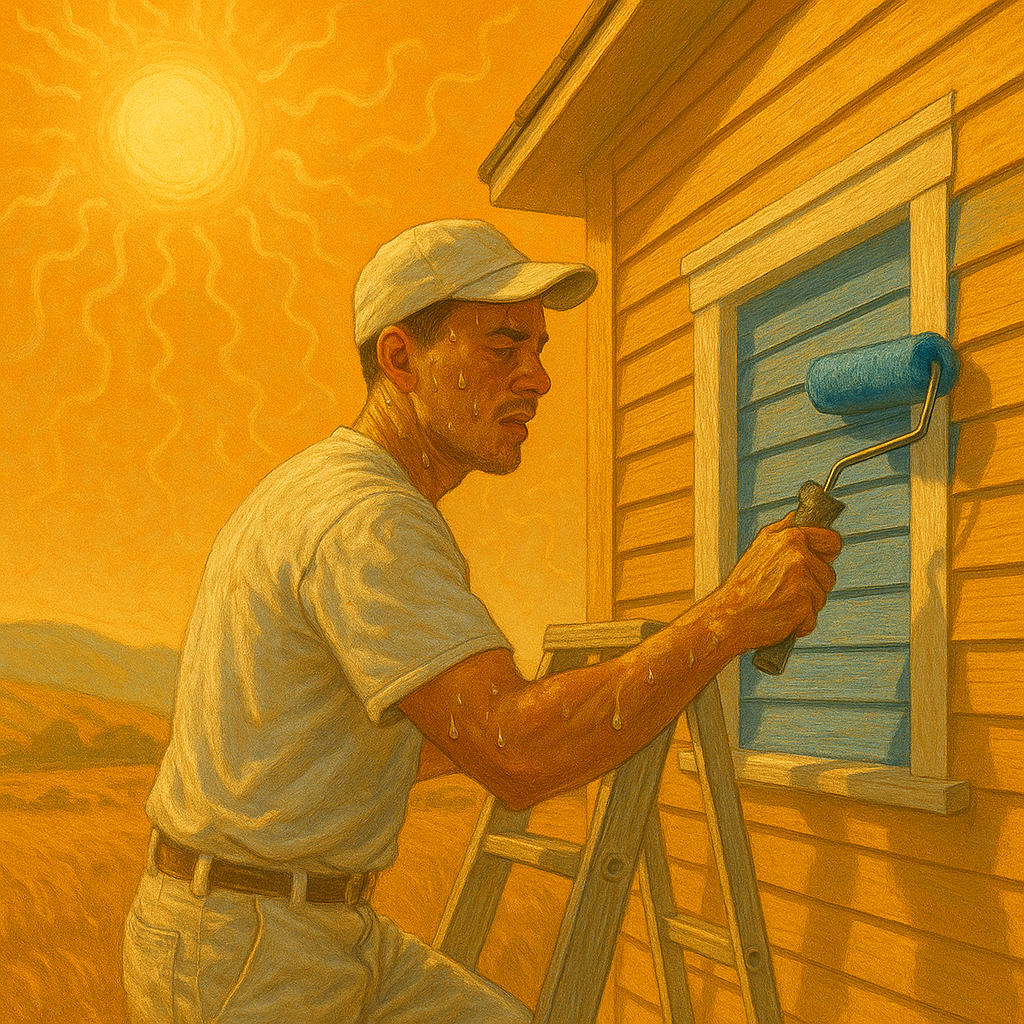
When planning an interior painting project, most homeowners focus on color selection, paint quality, and preparation techniques. However, one critical factor that significantly impacts paint application and final results often goes overlooked: temperature. The ambient temperature of your home during a painting project directly affects how paint flows, adheres, and cures—ultimately determining the longevity and appearance of your freshly painted surfaces.
Understanding how temperature influences interior painting helps you plan projects for optimal conditions, ensuring beautiful results that last. This comprehensive guide explores the science behind temperature’s effects on interior painting and provides practical advice for achieving professional-quality results regardless of season.
The Science of Temperature and Paint Performance
Paint is a complex mixture of pigments, binders, solvents, and additives—all of which react differently under varying temperature conditions:
How Cold Temperatures Affect Paint
When interior temperatures fall below 50°F (10°C), several problems can emerge:
- Increased Viscosity: Paint becomes thicker and more difficult to apply smoothly
- Poor Flow and Leveling: Brush marks and roller stipple remain visible rather than leveling out
- Extended Drying Time: Low temperatures significantly slow evaporation and curing
- Weak Adhesion: Cold surfaces prevent proper bonding between paint and substrate
- Uneven Sheen: Areas that dry at different rates develop inconsistent sheen levels
These issues lead to subpar results that may include visible application marks, poor coverage, and premature failure of the paint film.
How Warm Temperatures Affect Paint
While warmer temperatures generally improve paint performance, excessive heat creates its own challenges:
- Accelerated Drying: Paint dries too quickly, preventing proper leveling
- Difficult Application: Fast-drying paint makes it challenging to maintain a wet edge
- Lap Marks: Sections dry before adjacent areas can be blended properly
- Poor Film Formation: Inadequate flow time results in weaker paint films
- Visible Touch-Ups: Quick drying makes touch-ups more noticeable
Professional interior painting services understand these temperature effects and adjust their techniques accordingly to ensure optimal results regardless of conditions.
Ideal Temperature Ranges for Interior Painting
Most paint manufacturers specify recommended temperature ranges for optimal application and performance:
General Temperature Guidelines
- Optimal Room Temperature: 65-75°F (18-24°C)
- Minimum Safe Temperature: 50°F (10°C)
- Maximum Recommended Temperature: 85°F (29°C)
- Surface Temperature: Should be within 5 degrees of ambient temperature
Why These Ranges Matter
These recommended temperatures support:
- Proper Flow: Paint applies smoothly and levels effectively
- Optimal Drying Time: Allows proper film formation without excessive waiting
- Strong Adhesion: Ensures paint bonds correctly to the surface
- Consistent Appearance: Helps achieve uniform color and sheen
- Maximum Durability: Creates a film that will resist wear and cleaning
Seasonal Considerations for Interior Painting Projects
Different seasons present unique challenges and opportunities for interior painting:
Winter Painting Challenges
Winter interior painting requires special attention to:
- Indoor Heating: Maintain consistent temperatures throughout the painting process
- Cold Walls: Interior walls may be colder than room air temperature
- Humidity Issues: Dry winter air can accelerate paint drying at the surface
- Ventilation Limitations: Limited ability to open windows for fresh air circulation
- Daylight Hours: Shorter days provide less natural light for color assessment
Professional house painters adapt to these conditions by scheduling work during peak heating hours, using space heaters to warm surfaces directly, and selecting appropriate paint formulations for winter conditions.
Summer Painting Considerations
Summer brings its own set of challenges:
- Excessive Heat: Some homes may exceed optimal painting temperatures
- High Humidity: Can slow drying in some climates while accelerating it in others
- Air Conditioning Effects: Creates temperature differentials between rooms
- Direct Sunlight: Warms surfaces unevenly, particularly near windows
- Faster Drying Times: Requires adjusted application techniques
Professional painters compensate by working in climate-controlled environments, adjusting work schedules to cooler morning hours, and using appropriate painting techniques for warmer conditions.
Practical Temperature Management for Painting Projects
Whether you’re hiring professionals or tackling DIY painting, these strategies help manage temperature conditions:
Preparing for Cold Weather Painting
- Run heating systems continuously for 24 hours before painting begins
- Use infrared thermometers to check surface temperatures of walls
- Consider portable heaters to warm specific work areas
- Allow extra drying time between coats
- Keep doors and windows closed to maintain temperature stability
Adapting to Warm Weather Conditions
- Schedule painting during cooler morning hours
- Utilize air conditioning to maintain optimal temperatures
- Close blinds or shades to prevent direct sunlight on working surfaces
- Work in smaller sections to maintain wet edges
- Consider paint additives designed to extend open time in warm conditions
How Professional Painters Address Temperature Challenges
Experienced painting contractors employ several techniques to overcome temperature-related challenges:
Product Selection Based on Conditions
Professionals select appropriate products for specific temperature conditions:
- Low-Temperature Formulations: Specially designed paints that cure properly at lower temperatures
- Appropriate Primers: Primers formulated for challenging temperature conditions
- Specialized Additives: Products that extend drying time in warm conditions or accelerate it in cool environments
- Modern Paint Technologies: Latest-generation paints with broader temperature tolerance
Application Technique Adjustments
Professional painters modify their techniques based on temperature:
- Brush and Roller Selection: Different tools for varying temperature conditions
- Application Pressure: Adjusted based on paint flow characteristics at current temperatures
- Section Size Management: Working smaller or larger areas depending on drying conditions
- Layering Strategies: Adjusting coat thickness based on temperature
Environment Control Methods
Professionals actively manage the painting environment:
- Targeted Heating/Cooling: Directing temperature control to specific work areas
- Surface Temperature Management: Techniques to warm or cool surfaces directly
- Air Movement Control: Strategic use of fans to manage drying rates
- Humidity Management: Using dehumidifiers or humidifiers as needed
Temperature Considerations for Different Paint Types
Various paint formulations respond differently to temperature variations:
Water-Based Paints (Latex/Acrylic)
- Generally more temperature-sensitive than oil-based alternatives
- Minimum application temperature typically 50°F (10°C)
- Become too thick to apply properly in cold conditions
- Dry too quickly in very warm environments
- More susceptible to freezing damage during storage
Oil-Based Paints and Primers
- Better low-temperature performance than water-based options
- Become extremely viscous in cold temperatures
- Require more extensive ventilation regardless of temperature
- Take significantly longer to dry in cool conditions
- May yellow more quickly when cured in high-temperature environments
Specialty Coatings
- High-performance coatings often have stricter temperature requirements
- Epoxy and urethane products typically need warmer minimum temperatures
- Two-component products have temperature-dependent working times
- Textured and effect finishes may require specific temperature ranges for proper application
Conclusion: Temperature Planning for Successful Interior Painting
The temperature of your home during an interior painting project significantly impacts both immediate results and long-term performance. By understanding how temperature affects paint application and curing, you can plan projects for optimal conditions or take appropriate measures to compensate for challenging temperatures.
Whether you’re hiring professional painters or undertaking a DIY project, paying attention to temperature ensures your newly painted surfaces will look beautiful and perform well for years to come. For best results, always consult paint manufacturer guidelines for specific temperature recommendations and consider scheduling your painting projects during seasons when maintaining ideal temperatures is easiest.
Remember that professional painters have the experience, techniques, and specialized equipment to achieve excellent results even when temperature conditions aren’t ideal. Their expertise in adapting to environmental variables often makes professional painting services the most reliable choice for year-round interior painting projects.

